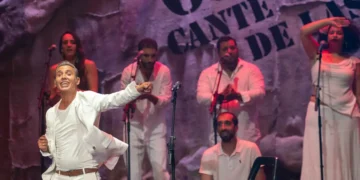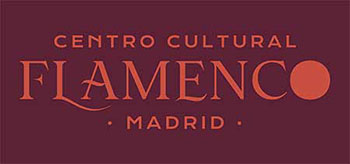|
14th Festival de Jerez 2010
|
|
Ballet Flamenco de Andalucía Text: Estela Zatania LORCA’S SOUNDTRACK Script and stage direction: José Carlos Plaza. Coreography: Cristina Hoyos. Music: Pedro Sierra. Dancers: Cristina Gallego, Rosa Belmonte, María del Mar Montero, Rocío Alcaide, Patricia Ibáñez, Zaira Santos, Marta Arias, José Luis Vidal, Jesús Ortega, Jacob Guerrero, Javier Crespo, Daniel Torres, Abel Harana, Juan A. Jiménez. Voice: Fabiola, Vicente Gelo, David Carpio. Guitar: Andrés Martínez, Ramón Amador. Percussion: Roberto Carlos Jaén. With the performance of the Ballet Flamenco of Andalucía under the direction of Cristina Hoyos, the 14th edition of the Festival de Jerez got underway last night. The city is full of foreign faces, and at midday, when singing erupted spontaneously at a sidewalk café near the plaza Arenal, a Japanese girl couldn’t resist the urge to dance some bulerías and immediately a smiling throng of flamenco fans gathered to keep rhythm. That’s how it is here right now, and for sixteen days Jerez ‘without fronteras’, normally more given over to cante and guitar as far as flamenco goes, will be the world mecca of flamenco and Spanish dance. The evening began with the voice of festival director Isamay Benavente explaining the tragic recent loss of Fernando Terremoto, originally scheduled to perform next week, and asking that the first applause of the festival be for him. That tribute ended up being the most moving moment in a long and artistically flat night, despite the best efforts of a numerous and well-prepared company, the clear intent of company head Cristina Hoyos and generous economic investment, both public and private.
The work was probably better-suited last summer to its one-month run in Granada at the Generalife of the Alambra. In that dramatic venue, you can almost understand the need to paint with broad brush-strokes and depend more on visual impact than artistic subtleties. But there are other problems. The choreography is repetitious and predictable giving a certain retro feel that becomes tiresome, possibly due to the fact that Cristina Hoyos choreographed all the dances. Then too, it’s admirable to allow individual company members their moment in the spotlight, but some dances and cante solos were far too long, hurting the pace of the work. A histrionic episode of danced saeta, complete with candles, drums and march music, tested the audience’s capacity to assimilate such over-sentimentality. On the upside, Cristina Hoyos’ brief appearances were the highpoints. At sixty-something, she has more theatrical and dancerly energy, or call it old-fashioned enthusiasm, than the rest of the group combined. Her personality and yearning to communicate remind us that flamenco dance is capable of high emotion, even without the generous resources at this work’s disposal. It’s also enjoyable to be reminded of Lorca’s beloved arrangements of songs from Spanish folklore: Anda Jaleo, Zorongo, Café de Chinitas, Los Cuatro Muleros, La Tarara, El Vito and other classics are the soundtrack of a country and its culture as they are identified in the work of Lorca, a never-ending source of inspiration for artists from a variety of disciplines. |





 Hoyos may just have committed the mortal artistic sin of falling in love with her own work. She’s in love with the beautiful wardrobe, and in love with off-stage voices reciting poetry. In love with her dancers, with the concept of a show within another show and of a small motorized stage that looks like an anthropomorphic four-poster bed when it glides around on the main stage. Like so many other works these days, this one labors under the burden of an overloaded libretto chock-full of confusing allusions and symbolism. Add dances that are too long and an even pacing that lacks contrast, and it’s a fool-proof recipe for a show that has you looking more at your watch than what’s happening on stage.
Hoyos may just have committed the mortal artistic sin of falling in love with her own work. She’s in love with the beautiful wardrobe, and in love with off-stage voices reciting poetry. In love with her dancers, with the concept of a show within another show and of a small motorized stage that looks like an anthropomorphic four-poster bed when it glides around on the main stage. Like so many other works these days, this one labors under the burden of an overloaded libretto chock-full of confusing allusions and symbolism. Add dances that are too long and an even pacing that lacks contrast, and it’s a fool-proof recipe for a show that has you looking more at your watch than what’s happening on stage.



















